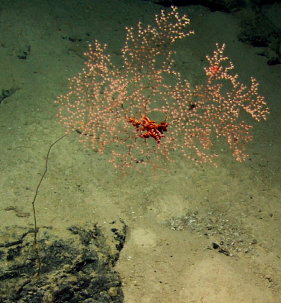
The octocoral Paramuricea ?biscaya with epibiont ophiuroid (brittle star) at 2077 meters depth on Corner Seamount. (Image copyright of the Deep Atlantic Stepping Stones Science Party; IFE; URI-IFO; and NOAA)

Black corals of the genus Parantipathes are host to chirostylid crabs, such as this one at 1689 meters depth on Caloosahatchee Seamount. (Image copyright of the Deep Atlantic Stepping Stones Science Party; IFE; URI-IFO; and NOAA)
Co-evolution and Dispersal of Deep-Water Corals and Their Associates on NW Atlantic Seamounts
There have been many observations of invertebrates living in association with deep-sea corals. In some cases, the corals serve simply as a 3D structure over which epibionts may temporarily climb to reach the faster-moving currents above the seafloor, but in other cases the epibionts appear to spend their entire life on the host coral. Deep-sea corals and their epifaunal associates are the dominant fauna inhabiting North Atlantic Seamounts, and provide an untested and “model” system in which to address co-evolutionary processes in deep-water marine systems. Many of these coral and epifaunal species form associations with high specificity, increasing the probabilities of uncovering intimate co-evolutionary processes and dispersal strategies. Are seamount coral and associated fauna populations evolving in isolation as larvae are retained in seamount-generated circulation? What are the evolutionary relationships of epibionts found on different genetic lineages of host corals? How tight is the relationship between host coral and associate epibiont? Is cladogenesis among the associates concordant with that of the host corals, indicating co-evolutionary processes? This project is a collaboration with Tim Shank (WHOI) and Rhian Waller (University of Hawaii), and our lab is analyzing the genetic patterns of variation of the four deep-sea coral taxa (shown above).
Research funding provided by the National Science Foundation


The octocoral Metallogorgia melanotrichos with ophiuroid at 2082 meters depth on Corner Seamount. (Image copyright of the Deep Atlantic Stepping Stones Science Party; IFE; URI-IFO; and NOAA)

The octocoral Candidella imbricata, seen here with dozens of ophiuroid epibionts at 1960 meters depth on Kelvin Seamount, also serves as host to a polychaete worm (Gorgoniapolynoe caeciliae) that lives in tunnels along the skeleton. (Image copyright of the Mountains in the Sea Research Team; IFE; and NOAA)